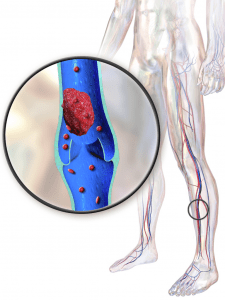It is said that we should always turn negative life experiences into positive life lessons. Let me illustrate this with a recent personal event.
Negative life experience
In early February, 2021, I found myself in a rather nice Orange County Hospital Emergency Room examining my leg and noting that the swelling had reduced by about a half overnight. Clearly the treatment was working. Asking the question posed by Talking Heads in Once In a Lifetime,
“Well… how did I get here?”
Two and a half weeks earlier I was in the gym doing front squats. On my first set, I felt an intense twinge near my right hip flexor. In true gym rat fashion, I trained around it, completing the workout. I took a couple of days off, and then returned using machines to train my upper body as my quad was still sore. Over the next couple of days, the quad began to swell, and the swelling move downwards. My knee swelled up, then my calf, then my foot and lastly my toes became discolored. During all this, everything was becoming so much more painful. Walking was agonizing and I was using a crutch.
The healthcare professional friends I consulted agreed with me that it sounded like a tear in my quad. Eventually I bit the bullet and had a Zoom consultation with a friend at her clinic who recommended I go to Urgent Care, in the hope it was an easy fix. They, however, found that my quad was fine, but that I had Deep vein thrombosis (DVT) – two blood clots in two veins located in my right calf. They then referred me to their Emergency Room.
Treatment was easy. I was placed on a drip giving me blood thinners, and the following day I was given blood thinner tablets. Every day the swell is going down a bit, the pain is reducing, and my body is hopefully absorbing the blood clots. I am on the road to recovery. In another week or two, all this will be just a memory…

Depiction of a deep vein thrombosis
Positive life lesson
The most obvious lesson I learned was gratitude. I was grateful to the friends who pushed me to get medical assistance rather than just waiting it out, hoping it would heal on its own. I am extremely grateful for my support network – people who have been contacting me constantly to see how I was progressing, one person in particular who visited me almost daily to assist me in the late afternoon, and another friend who lent me his crutch so I’d be able to walk properly. I am also grateful to the hospital staff who diagnosed me before my condition could turn potentially life threatening, had the clot moved upward.
You’ve probably seen memes along the lines of:
“If you have food in your fridge, clothes on your back, a roof over your head and a place to sleep, you are richer than 75 percent of the world. … “
My fridge may not be stocked with caviar, truffles and Dom Perignon champagne, but it does have wholesome mostly organic foods. The clothes on my back aren’t Dolce & Gabbana but comfortable clothes made from natural fabrics. I don’t live in a waterfront mansion, but I do have a place to shut away the world. I don’t drive a Ferrari, but I do have a reliable old Toyota.
The point is that I have my needs covered rather than my wants. My gratitude workings tended be along those lines. My blood clot experience has taught me that I was wrong and that I wasn’t going far enough. There is so much that I was taking for granted, in particular my health.
I have often bragged that my superpower is to be able to fall asleep anywhere, anytime. Experiencing constant pain in my leg effectively constitutes Kryptonite to my superpower.
Over the last three weeks I’ve realized that there are a number of things that I have taken for granted:
- Being able to get out of bed or off a chair and walk wherever I wanted to – I’ve had to lean on a chair and wait a few minutes for the pain to subside before I can walk anywhere.
- Being able to shower without a fear of losing balance and falling over.
- Being able to reach down and easily put on socks and shoes.
- Being able to walk and stand for hours on end.
In another week or two, I’ll be back to normal, but there are people who deal with chronic pain and have limited mobility for very long periods of time. I now have a far greater appreciation of some of the challenges they face and the courage they display daily. I also realize that I have far many more things to be grateful for than I first realized.
A word of caution about blood clots
After many years of training, I was sure that I knew my body. But I didn’t realize that I had two blood clots.
I have heard of a couple of cases similar to mine. One guy was convinced he had torn a muscle, only to find he had a blood clot. His case was far more serious than mine as he required a stay of two weeks, rather than overnight like mine was.
Another guy went to a masseuse, asking her to work on the pain in his calf. She took one look at it, refused as she realized it was a blood clot, and insisted he go to hospital. He returned a week later to thank her.
This last case shows how important it is to go to a trained massage therapist, as they would realize that:
“A thrombosis is a blood clot. It can be lodged in a vein-DVT (deep vein thrombosis). Massage is contraindicated because it may dislodge the clot which could send it through the circulation where it could lodge in the lungs causing a pulmonary embolism-a life threatening condition.”
Other possibilities are a heart attack or a stroke.
The need for timely competent medical advice
Gym rats make the worst patients as they expect to go through life with a certain amount of pain, while others will race off to a healthcare professional at the first sign of trouble. It’s better to be safe than sorry, so if any injury doesn’t go away as quickly as it should, have it checked out.
Also remember the need for regular checkups. The Mayo Clinic advises that they are important, especially now during the COVID-19 pandemic:
“Historically, men have been hesitant to seek medical attention when something seems wrong with their health. Additionally, men aren’t as likely as women to have preventive screenings and checkups with their health care provider. This is a problem because early detection of a medical issue is the best way to improve effectiveness of condition treatment and management.
In addition, early COVID-19 research has found that more men are dying from COVID-19 than women, in part because men are more likely to have underlying health conditions. Delaying or avoiding a checkup or screening during the COVID-19 pandemic — or beyond — could lead to a treatable situation turning deadly. …
Men older than 50 should have a yearly physical exam, and men younger than 50 should have a physical exam every three to five years. Even if you’re feeling healthy, a regular checkup with your provider is a good way to validate your health or identify a problem in its early stages.”
So, be grateful for your health, and never take it for granted…
Tony Mierzwicki
Author of Hellenismos: Practicing Greek Polytheism Today and Graeco-Egyptian Magick: Everyday Empowerment.
















